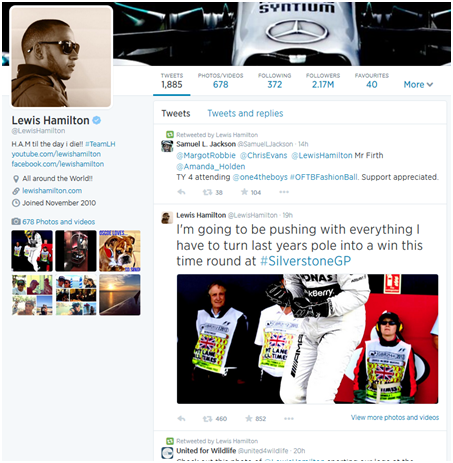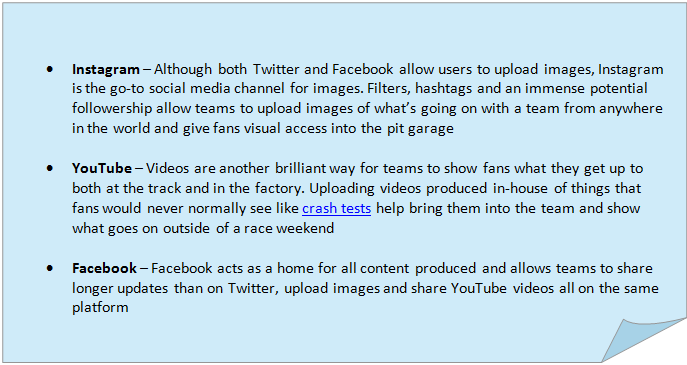How Formula 1 is Changing Online
- Subscribe to RSS Feed
- Mark as New
- Mark as Read
- Bookmark
- Subscribe
- Printer Friendly Page
- Report to Moderator
- Plusnet Community
- :
- Plusnet Blogs
- :
- How Formula 1 is Changing Online
How Formula 1 is Changing Online
 The 50th Formula 1 race at Silverstone takes place on the 4th - 6th July and with it comes the opportunity to see the world’s best teams and drivers, racing around the historic track. But for those fans not fortunate enough to follow the sport in person as it travels around the world, just how important is social media to their experience? Plusnet went behind the scenes to find out….
The 50th Formula 1 race at Silverstone takes place on the 4th - 6th July and with it comes the opportunity to see the world’s best teams and drivers, racing around the historic track. But for those fans not fortunate enough to follow the sport in person as it travels around the world, just how important is social media to their experience? Plusnet went behind the scenes to find out….
How social media has adapted to Formula 1
Like all sports, teams and fans have quickly adapted to use social media in different ways. Formula 1 has been one of the more recent sports to use social media to engage with fans and respond to breaking news, situations on the track and an unprecedented insight like never before. This is also case for media organisations, such as the BBC, desperate to drive traffic to and keep fans without social media accounts abreast of information and embedding all the content in one place.  This engagement and use of social media in the sport is something that is measured annually in the Formula 1 Social Media Index, through an algorithm as well as the opinions of expert judges with knowledge of social media. The 2013 index put Lotus F1 at the top of the social media leader board with Williams in 2nd and Red Bull in 3rd, measured across eight different platforms from Twitter to Vine. The index measures a number of factors from followers and growth of interactions to the range of multimedia offered by the platforms. However, despite Lotus’s success in this, they still do not have the accolade for most followers on Twitter with household F1 brands Ferrari and McLaren taking the top two spots no doubt because of their profile within the sport.
This engagement and use of social media in the sport is something that is measured annually in the Formula 1 Social Media Index, through an algorithm as well as the opinions of expert judges with knowledge of social media. The 2013 index put Lotus F1 at the top of the social media leader board with Williams in 2nd and Red Bull in 3rd, measured across eight different platforms from Twitter to Vine. The index measures a number of factors from followers and growth of interactions to the range of multimedia offered by the platforms. However, despite Lotus’s success in this, they still do not have the accolade for most followers on Twitter with household F1 brands Ferrari and McLaren taking the top two spots no doubt because of their profile within the sport.
| Team | Followers |
| Ferrari | 815,000 |
| McLaren | 610,000 |
| Red Bull | 512,000 |
| Mercedes | 496,000 |
| Lotus | 418,000 |
So how important is social media from a team perspective and why? And is it really all necessary?
“Social media is incredibly important” says Tom Webb, Head of Communications at Caterham F1. “I think Formula 1 is an exclusive sport, and to get in is an incredibly difficult task. One of the things social media has done is to make the exclusive environment inclusive. We are able to virtually bring people into the garage and give them an insight into what takes place right in the heart of the team over a race weekend using social media.”
By uploading pictures, videos and updates on what’s happening both on and off-track teams are able to offer this vital insight instantly to fans across the world, giving them more information on what it’s like to work in, and be part of, a Formula 1 team. This is good not only for fan engagement, but for impromptu press releases as well, according to Tom
“If something takes place in a race… then the way that we can inform the media and the fans about what’s been going on is to use Twitter.”
This immediate communication lets teams give fans updates when they otherwise wouldn’t have been able to. Suddenly information which wouldn’t normally be considered newsworthy – updates on race days, quotes from drivers, images from the pits – can be released by teams and accessed by fans, giving them a much wider overview of what a Formula 1 team does than would be available in print or on TV. Giving fans this virtual inclusion into a team can make them much more engaged with a brand, which works in everyone’s favour. The instantaneous nature of Twitter also allows for major updates to be provided quickly, most recently seen in the aftermath of the Massa/Perez incident on the last lap of the Canadian Grand Prix. Despite it being a huge crash, both teams were able to give instant updates on the welfare of their drivers.
Drivers also a major part of the experience
And it doesn’t stop there. Even the drivers are now getting in on the act as people look to be involved more in a sport star’s life.
“I think it’s equally important for drivers to have social media because again, F1 is a sport which is almost the reverse of other competitive sports. In F1, people tend to follow the drivers” says Tom.
Unlike football where people will be fans of teams, F1 fans support drivers, regardless of what car they drive. This can most recently be seen with Lewis Hamilton and his move to Mercedes – where people were once wearing McLaren shirts, Mercedes is now a firm favourite. This influence with fans is something that’s very valuable to teams – a driver with a strong fan base will help increase merchandise sales and make them more money. Lewis Hamilton is currently the most followed driver in Formula 1, with 2.14 million people following his account. His regular updates of images, tweets about what he’s doing and retweeting of fans has helped put him nearly 1.5 million followers clear of Mercedes teammate Nico Rosberg’s 561,000 followers. 
How are teams using the other social media platforms?
Of course a lot of teams use more than just the above four – there’s Pinterest, Vine, Google+ and many more to choose from – however Instagram, YouTube and Facebook, as well as Twitter, all allow teams the most visibility and reach, helping them to make the most impact. At the end of the day, the more brand exposure a team can get, the more likely both they – and drivers – are likely to attract partners, sponsors and investors to help improve cars and the technology inside. Social media undoubtedly plays a small part in the overall success of the team.  No matter who wins this year’s Silverstone Grand Prix, you can guarantee that it’ll be the talk of social media for the weekend! Who do you want to win?
No matter who wins this year’s Silverstone Grand Prix, you can guarantee that it’ll be the talk of social media for the weekend! Who do you want to win?
